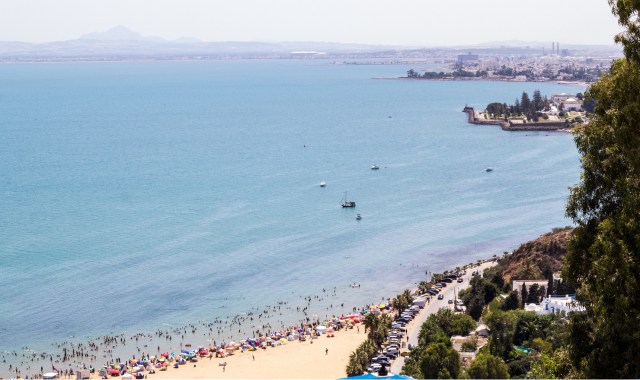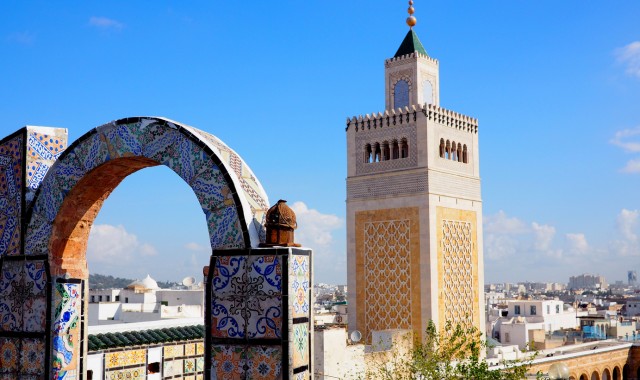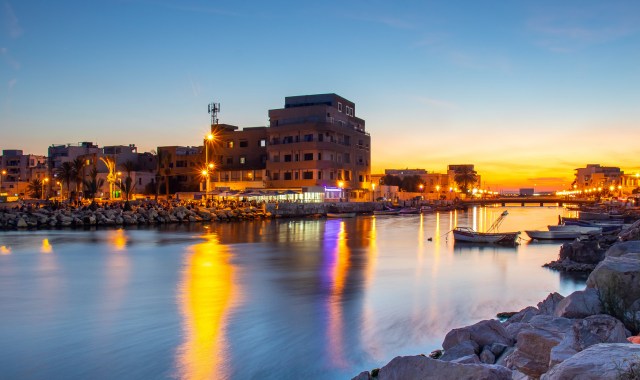Tunis
TunisiaTunis, the capital of Tunisia in North Africa, is situated on the Mediterranean coast. It boasts a rich architectural heritage, a charming medina, bustling markets, and a lively arts and culinary scene, making for a stylish city break.
On Ferryhopper, you can book ferry tickets online to Tunis with no hidden fees! Keep reading to find the best tips about your holidays in the city as well as all the information you need about ferry routes and the port of Tunis.

View to the famous ruins of ancient Carthage, Tunisia
Vacation in Tunis
Welcome to Tunis, the lively capital city of Tunisia! Known for its rich history, cultural heritage, food variety, and stunning architecture, Tunis offers a plethora of exciting activities for every type of traveler.
History enthusiasts will be captivated by the city’s wealth of historic architecture and interesting attractions, none more remarkable perhaps than the ancient city of Carthage. Art and culture lovers will appreciate the numerous galleries, theaters and music festivals that showcase Tunisia’s vibrant arts scene.
The city is also a great destination for foodies, with its delicious street food, traditional Tunisian dishes, as well as cool cafes and restaurants. In addition, Tunis offers beautiful beaches along the Mediterranean coast, providing opportunities for relaxation and water sports.
How to get to Tunis?
You can get to Tunis by ferry from Italy and France. For more information about schedules and tickets, you can take a look at the ferry routes to Tunis.
Alternatively, you can reach Tunis by plane. The Tunis Carthage International Airport is approximately 7 km from the city serving connections from several European countries. Taxi services are available at the airport. Travel time to the center of Tunis by car is 20 minutes.
What to do in Tunis
There’s no better way to start your holidays in Tunis than by getting lost inside the Unesco-protected Medina (old town), one of the most impressive medieval medinas in North Africa. Discover its ancient streets and alleyways, marvel at its ancient palaces, hammams and mosques, and embrace the chaos of the souks (Arabic markets) selling beautiful artisanal products. Don’t forget to sample some delicious Tunisian street food along the way!
Then, you can head to Tunis' ville nouvelle (new town). Here, must-visits include Avenue Habib Bourguiba, a beautifully wide avenue lined with palm and eucalyptus trees, as well as the imposing St. Vincent de Paul Cathedral.
If you’re a history buff, the most essential cultural visits are to the Bardo Museum and the ancient ruins of Carthage, both of which will provide you with a fascinating glimpse into Tunisia’s rich past. Afterwards, take a leisurely walk along the picturesque Byrsa Hill and enjoy panoramic views of the surrounding area. Finish your day with a visit to La Goulette, Tunis’ port, where you can indulge in a seafood feast while enjoying the stunning sunset over the Mediterranean.
If you feel like taking a break from the hustle and bustle of the city, head to the trendy neighborhood of La Marsa. Stroll along the picturesque waterfront promenade, enjoy the bustling cafes and restaurants, or simply relax on the sandy beach. Finally, if you’re traveling to Tunisia in the fall, winter, or spring, make sure to visit a local hammam.

A narrow picturesque street in the Medina of Tunis, Tunisia
Beaches in Tunis
Tunis and its suburbs have some of the most beautiful beaches located in the country as well as in the Arab Maghreb region in general. Here are the top beaches in Tunis:
- La Marsa: 16 km from the city, La Marsa is an organized moon-shaped beach with golden sand, calm waters and a lovely atmosphere. View to Gammarth is charming and there are a number of restaurants, shops and bars nearby. In colder months, you can come here for a romantic afternoon stroll.
- Hammamet: just a 1-hour drive from Tunis, Hammamet’s superb stretches of fine white sands are among the most well-known beaches in Tunisia, bathed by warm waters and an incredibly diverse marine life.
- Sidi Bou Said: 20 km from Tunis, this is a charming picturesque hillside village characterized by its white and blue colors. On the bottom of the hill, there is a marina and a beach where you can swim in.
- Ghar El Melh: for families searching for a day excursion this beach is ideal. It offers a variety of activities, including swimming, sunbathing, beach volleyball, and picnics.
- El Haouaria: an unspoiled beach, surrounded by nature and picturesque villages. It is also a hotspot for birdwatchers between March and May.

View of the crowded Sidi Bou Said beach and seafront
Sightseeing in Tunis
Ancient history is ingrained in Tunisia, from the evocative medina to the ruins of once-powerful Carthage. Here’s what to see and do in Tunis:
- The Bardo Museum, 4 km from the city center, it has one of the most magnificent collections of Roman mosaics in the world
- The Unesco World-Heritage protected Medina
- The Dar Ben Abdallah, an old palace in the Medina of Tunis
- The Zitouna mosque in Medina, dating from 732 CE
- The ruins and the National Museum of Carthage
- The Baths of Antoninus in Carthage, one of the largest Roman thermal sites in the world
- The Cathedral of Saint Vincent de Paul, the largest surviving building of Tunisia's French colonial period
- The Belvedere Park and the Museum of Modern Art

The Ez Zitouna Mosque (Great Mosque) overlooking the medina of Tunis
Nightlife in Tunis
Tunis offers a vibrant and lively nightlife scene, with an exciting assortment of bars, lounges and nightclubs scattered throughout the city.
The best area to go out and experience the nightlife in Tunis is the popular district of La Marsa, which is known for its trendy bars, clubs and restaurants. On a Friday or Saturday night, you can also head to clubs in Gammarth or the central district and dance the night away to traditional Tunisian music (Malouf).
If you’re looking for something more chill, make sure to head to the city’s lounge bars, an important part of Tunis nightlife.
Useful info: during Ramadan, the Tunis Medina Festival livens up the Tunisian capital each year. A programme of cultural events, from international films to musical performances, spring up across a range of venues.
Food in Tunis
Gear up for quite the foodie adventure - Tunisian cuisine is a vibrant and flavorful reflection of the country’s rich cultural heritage. Known for its variety of palate-pleasing delights, Tunisian food offers a fusion of Mediterranean, Arabic, Berber, and French flavors. Be aware that Tunisian food can also be spicy! Harissa is a common household staple made of chili peppers that is used in many dishes.
Here are some local delicacies to try in Tunis:
- couscous or kosksi (made spicy with harissa sauce and served with lamb, beef, fish, and other types of seafood)
- mechouia salad (with hard-boiled eggs, olives, or tuna)
- chakchouka (eggs poached in a spicy tomato sauce)
- lablabi (Tunisian chickpea soup)
- kafteji (fried vegetables combined with eggs and seasoning)
- makrouds (cookies made with dates and nuts)
- bambalouni (traditional Tunisian doughnuts)
- assidat zgougou (dessert consisting of a thick layer of the pine pudding and then a thin layer of regular vanilla custard)
- kaak warka (pastries shaped into rings filled with marzipan that's flavored with rosewater)
- ghrayba (shortbread cookie)
- Tunisian mint tea
Tip: Tunisian food markets such as Tunis' Marché Centrale are must-sees! The Central Market is housed in a building dating back to 1891 in the middle of downtown. For freshly roasted coffee beans and spices head to Rue d'Espagne; for olives and pickles head to Rue du Danemark.

A plate of couscous, the centerpiece of traditional Tunisian cuisine
Tips for your holidays in Tunis
Here are some tips that we hope will be useful to you during your stay in Tunis:
- The most attractive section of the medina is Rue Sidi Ben Arous and its continuations Rue Dar El Jeld and Rue du Pacha. Make sure to go there in the early morning, when it’s less busy and the weather’s cooler.
- Before leaving the medina, make sure to pass by Souk El Attarine (the Perfume Makers’ Souq). It was built in the 13th century and is still home to shops selling fragrant oils and waters.
- If you have a car, we recommend driving 2 hours away from Tunis to meet the craftswomen of Sejnane. They are clay artists preserving a unique 3,000-year-old pottery-making tradition. Their craft is now part of the Intangible Cultural Heritage of Humanity from UNESCO.
- For those with a great hunger for ancient history, a day trip to Dougga is well worthwhile. UNESCO qualified Dougga, the best preserved Roman city in North Africa, is a 2 hour drive south-west of the capital.

The impressive archaeological site of Dougga, in the north-west region of Tunisia
Useful information about Tunis
Situated in the Gulf of Tunis, behind the Lake of Tunis and the port of La Goulette, the greater metropolitan area of Tunis, often referred to as "Grand Tunis", has about 2,700,000 inhabitants. It offers a wide range of amenities for visitors, from shops and street markets to several hospitals and pharmacies.
Regarding accommodation, in Tunis there are a large number of hotels and resorts. The Medina of Tunis is a fantastic area to stay if you want to get a glimpse of traditional Tunisian life and be close to many important sights. Alternatively, you can stay at either Tunis Centre or Les Berges Du Lac, a modern, upscale neighborhood.
If you prefer to avoid the crowds of tourists, the best time to visit Tunis is during the spring or early fall. For those who like warm weather, the hottest month of the year is July, while most rainfall occurs from December till March.
Important phone numbers for your stay in Tunis
Here are some useful contacts to keep handy during your trip to Tunis:
- Port Authority of Tunis: +21671735300
- Tunis University Hospital: +21671397000
- Tunis Police Department: +21671505403
- Tourist information center: +21671105400
- Tunis-Carthage International Airport: +21671754000
Transportation in Tunis
Buses, the light Tunis Metro rail system and a regional train service that connects the city center to some of Tunis's northern suburbs make up the city’s extensive public transportation network.
Societe Nationale de Transport Interurbain (SNTRI) runs more than 200 bus routes in Tunis while SNCFT is Tunisia’s main rail network. The Tunis Métro is made up of 6 lines and covers a substantial part of Tunis and its neighboring suburbs.
Taxis are another simple, inexpensive and comfortable way to get about. Make sure that the driver turns the meter on, so that you do not get overcharged. In case you want to drive your own car or rent one upon arrival, keep in mind that the major issues with driving in Tunis are the lack of parking spaces, the traffic and the narrow streets.
Overall, much of Tunis can be easily explored on foot, making it ideal for those who wish to take their time discovering the city.
Ports in Tunis
Tunis’ port, La Goulette, is one of the most popular ports in Tunisia, based across the Mediterranean Sea, and is mainly known for transporting passengers. It was established in 1835 and is located about 11 km from the Tunis town center.
To serve the needs of the modern traveler, the ferry terminal features various shops, dining options and banks.
Tunis ferry: schedules and tickets
The port of La Goulette normally serves ferry routes from the Italian cities of Civitavecchia, Genoa, Salerno, and Palermo, as well as from Marseille in France.
The companies offering ferry services from Europe to Tunis are GNV, Grimaldi Lines, Corsica Linea, and CTN Ferries.
There are several crossings from Italy and France to Tunis:
- Civitavecchia - Tunis ferry: there are normally 2 weekly ferry crossings from Civitavecchia to Tunis all year round. Ferries arrive at the port of La Goulette and the trip duration ranges from 17.5 hours to 28 hours. Ferry ticket prices from Civitavecchia to Tunis start at approximately €56.
- Genoa - Tunis ferry: ferries from Genoa to Tunis are available with 2-3 weekly crossings throughout the year. The Genoa to Tunis ferry duration ranges from 17.5 hours to 27 hours and ferry price starts at €100.
- Salerno - Tunis ferry: the ferry route to Tunis from Salerno runs 2 weekly crossings. The journey takes approximately 23-27 hours and tickets start at around €50.
- Palermo - Tunis ferry: ferries from Palermo to Tunis normally depart around 3 times per week. The ferry ride from Palermo to Tunis takes about 10-14 hours. Ticket prices start at approximately €30-€40.
- Marseille - Tunis ferry: there are up to 6 weekly crossings from Marseille to Tunis. The journey takes about 20.5-25 hours with a ticket cost of around €130.
Tip: if you want to know more about the Italian ferry schedules, check out our dedicated article!

The trendy port town of La Goulette during sunset, Tunis
Book your ferry tickets to Tunis online
Book cheap ferry tickets to Tunis online on Ferryhopper with no hidden fees. Compare routes and ticket prices, and organize your trip to Tunisia with ease! On our Map of ferries, you can also see all available connections between Europe and Tunis at a glance.
Tunis ferry schedule
View the complete ferry schedule from and to Tunis for the upcoming week. Find up-to-date trip information, including departure and arrival dates and times, ferry operators and ticket prices.